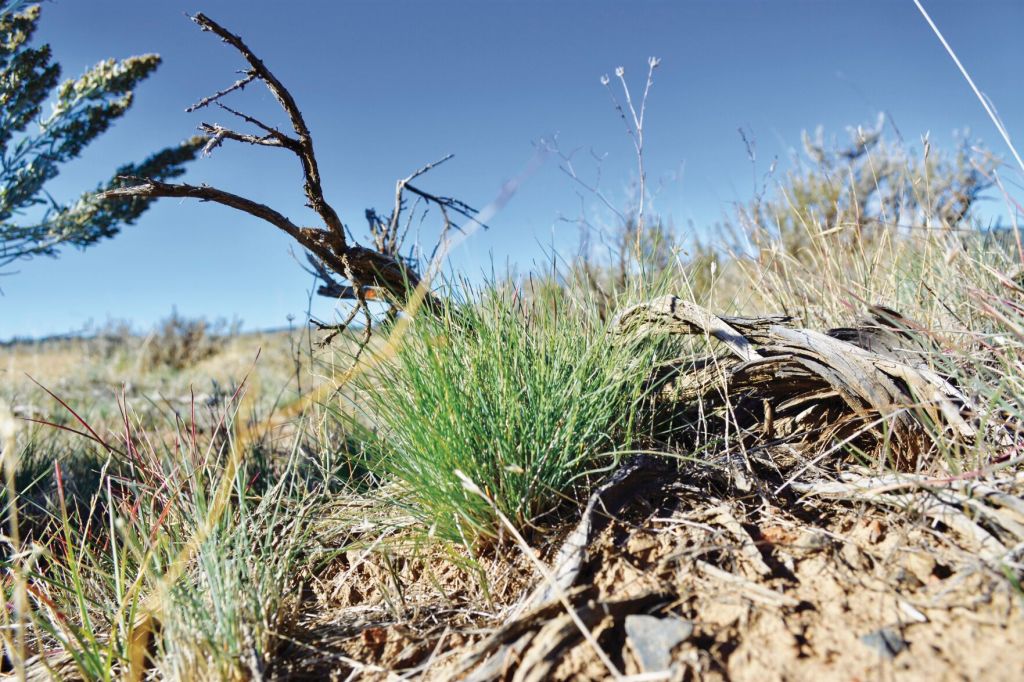Fall grass flush a boon for wildlife preparing for winter
Published 7:00 am Monday, October 9, 2023

- Idaho fescue, a native bunchgrass, growing among sagebrush south of Baker City on Thursday, Oct. 5, 2023. An unusually damp late summer has resulted in an abundance of green forage, a boon for wildlife as well as cattle as winter approaches.
BAKER CITY — The adjectives fly thickly as wildlife biologists talk about habitat conditions for deer and elk as they brace for the frequently harsh Northeast Oregon winter.
“Fantastic” is a favorite.
Also “phenomenal.”
The less exuberant, but still positive, “good” also is uttered.
The source of this optimism is a flush of fresh, nutritious foliage — primarily grass but also a variety of palatable shrubs.
This autumn bounty, spurred by an abnormally damp late summer, should help big game animals amass the fat reserves that help sustain them through the frigid months when food is scarce, say biologists from the Oregon Department of Fish and Wildlife.
A fall greenup can be crucial in sparing animals from winter’s deprivations. Deer, in particular, lacking the body mass of elk, are especially vulnerable, biologists say.
During the winter of 2016-17, for instance, when snow accumulated to depths of 2 feet or more even in the valleys and temperatures plummeted to 20 below zero, hundreds of deer died across Northeast Oregon.
The Oregon Fish and Wildlife Commission responded by cutting in half the number of hunting tags for the 2017 deer season. Tag numbers haven’t returned to levels prior to that winter, the most severe in the region since 1992-93.
Gorging on the green
Two main factors determine the extent of the fall greenup, said Brian Ratliff, district wildlife biologist at ODFW’s Baker City office: rainfall and soil temperature.
The latter isn’t usually an issue until later in the fall, he said, as the ground typically remains warm enough to allow grass to grow into November.
Rain, by contrast, is much less reliable. On average, September is the second-driest month at the Baker City Airport, and August and October are tied as the fourth-driest.
If those three months are parched, grass tends to be desiccated and lacking in protein through the fall, Ratliff said. Deer and elk, relying on such poor forage, are likely to enter winter without the thick fat layers they need to endure a prolonged winter.
But 2023 has been an anomaly. August, in particular.
The soggy remnants of Hurricane Hilary swept through the region on Aug. 21. The storm was especially potent in Baker County, where more than 3 inches of rain fell in places.
The result, Ratliff said, was a “phenomenal greenup” that has persisted into October.
“It’s literally green everywhere,” Ratliff said.
Jeff Yanke, district manager for ODFW’s Enterprise office, said “we’re seeing forage really benefit from this rain for sure. It’s getting animals well prepared for the winter.”
Matt Keenan, district wildlife biologist at ODFW’s La Grande office, echoed his colleagues’ observations.
“I think we’re definitely going to have a pretty strong fall greenup this year,” Keenan said. “Hopefully this puts us into winter with animals in pretty good condition.”
John Wirth, a cattle rancher who lives near Medical Springs, close to the border between Baker and Union counties, said the abundance of green forage is a boon for his cattle as well as for wildlife, including big game animals and upland game birds such as chukars, which feed on annual grasses such as cheatgrass.
“It looks better than it did last year,” Wirth said. “It’s going to save a lot of wildlife, I think.”
Deer, elk mainly staying out of agricultural lands
During dry years, of which there have been several over the past decades, deer and in particular elk, lacking good feed on their summer range in the mountains, often migrate to valleys where the meadows and alfalfa fields are still green, Ratliff said.
So far this year, though, he’s received relatively few complaints about big game animals moving onto farms and ranches.
Ratliff said deer and elk prefer to eat native forage, such as bunchgrasses, so when those are available at higher elevations the animals tend to stay there until cold weather and snow prompt them to descend to winter range.
Ralph Morgan, a cattle rancher who has land in Bowen Valley, just south of Baker City, said elk and deer hadn’t moved to lower elevations by late September, as they often do during dry years.
Keenan also said he has had few complaints about big game animal damage this late summer and fall.
Yanke said archery hunters reported that deer and elk were more scattered during the season, which ran for most of September. With both forage and water widely available, the animals didn’t need to congregate around relatively few such sources, he said.
Learning more about benefits of fall forage
Keenan said recent research at the Starkey Experimental Forest, west of La Grande, suggests that mule deer sometimes struggle to find sufficient forage during the summer.
Climate change, he said, is shortening the period each year when forage is especially nutritious.
“We’re starting to realize they’re just not getting the nutrition they need,” Keenan said, referring to mule deer. “Summer range, we’ve learned, is more important than we used to think.”
Summer rain — the Aug. 21 storm being a notably damp example — can extend the period when forage is plentiful, Keenan said.
He said he’s optimistic that deer and elk will continue to have access to protein-rich forage until snow begins to accumulate and they move onto winter range.
“It is a crucial time,” Keenan said. “I’m hopeful.”
Benefits for bucks?
Although animals will take advantage of green forage at any point in the fall, a later greenup, just before snow arrives and the ground freezes, can give buck deer in particular a boost, Ratliff said.
Bucks expend a lot of energy pursuing does during the rut — the breeding season that typically takes up much of November.
Bucks can be vulnerable to hard winters if they can’t replenish some of their fat reserves before temperature plunge and snow covers some of their feed, Ratliff said.
He’s hoping for occasional rain to continue through the fall, which should extend the greenup.
“It’s literally green everywhere.”
— Brian Ratliff, district wildlife biologist, Oregon Department of Fish and Wildlife’s Baker City office





